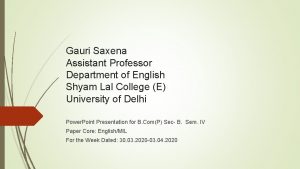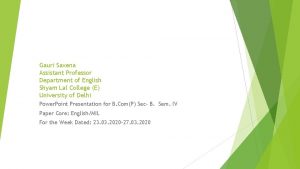GAURI SAXENA DEPARTMENT OF ENGLISH ASSISTANT PROFESSOR SHYAM






- Slides: 6

GAURI SAXENA DEPARTMENT OF ENGLISH ASSISTANT PROFESSOR, SHYAM LAL COLLEGE(E) UNIVERSITY OF DELHI POWERPOINT PRESENTATION FOR B. A. (H) Generic Elective Sem. IV READINGS ON INDIAN DIVERSITY AND LITERARY MOVEMENTS FOR THE WEEK : 27. 04. 2020 -01. 05. 2020

UNIT 3 : LANGUAGE POLITICS : HINDI AND URDU 1. This Unit deals with the close connect between language and politics in the historiographic and geo-political context of the Indian sub-continent. 2. Of the four component topics viz. Amrit Rai’s essay ‘Introduction: A Conspectus’ to A House Divided, Amir Khusrau’s poem Ghazal, Rajinder Singh Bedi’s short story Lajwanti and Rahguvir Sahay’s poem Hindi, this presentation will focus on Rajinder Singh Bedi’s story Lajwanti. 3. As has already been discussed in the foregone lectures, on other topics in the Unit this Unit introduces us to the linguistic development of the two modern Indian languages namely, Hindi and Urdu, which have played a crucial role in shaping the unique literary-cultural heritage of the Indian subcontinent. 4. Literature has been the voice of the masses in times of social and political turmoil and Rajinder Singh Bedi’s short story Lajwanti takes the reader back to the days of political turmoil caused by the Partition, as it poignantly draws attention to the impact of such political decisions on the microcosmic dimension of human relationships as they unfold in the story. 5. Students are required to read the short story, included in the prescribed textbook, as per the syllabus circulated by the University of Delhi alongwith the prescribed readings.

EXPLANATORY NOTES ■ The story, presented in its translated version, opens with a poignant couplet that highlights the delicate nature of relationships and also becomes a metaphorical reflection on the lead protagonist who gets her name from the ‘touch-me-not’plant, ‘Lajwanti’ ■ The story delineates the incident just after the Partition with an attempt being made by the main protagonist Sunder Lal to rehabilitate the displaced women of the community who face social stigmas and are rejected by their families. ■ The story moves back and forth in time, with the opening sections of the story delineating the character of the lead protagonist, Sunder Lal, a devoted volunteer who works tirelessly in his efforts towards social rehabilitation of the displaced an equally, devoted, loving husband who deeply misses and is worried about his wife, Lajwanti, who was lost in the turmoil of Partition.

EXPLANATORY NOTES ■ In the flashback mode the omniscient narrator gives an insight into their conjugal relationship, through Sunder lal’s reminiscences in which Sunder Lal, quite contrary to the worried husband of the opening sections, is a typically domineering husband Lajwanti, ‘his’ unquestioning, coy and dutiful wife. ■ With the help of such techniques the narrator gives depth to Sunder Lal’s character who emerges as a highly complex character, who is a product of his social milieu and times. ■ These reflections which are often coloured with metaphoric re-imaginings of the past, be it the remembrance of slave trade or a reflection on the re-union of Ram and Sita become a means of commenting on the position of women in society across ages.

EXPLANATORY NOTES ■ The re-union of the family members with abducted women highlights the pitiable condition of women and comments on the double standards of society, problematising the idea of ‘rehabilitation’ with the zealous slogan that Sunder Lal zealously gives voice to. ■ The comparison of their reunion with the epic re-union of Ram and Sita anticipates the strained nature of their relationship as it would unfold. ■ The changing nature of Sunder Lal and Lajwanti’s relationship is already apparent through the excessive emphasis on the ‘name’ and the many connotations it has in the social milieu of a rural setting, something that the opening couplet has drawn our attention to. ■ Sunder Lal’s noticing the physical appearance of his long-lost wife, asking about the marks of tattoo on her body and his refusing to use his earlier terms of endearment calling her ‘Devi’, bring into focus the collapse of a relationship which could not bear the brunt of social pressures. ■ Lajwanti emerges as a victim of not just political turmoil but of those social institutions which take away a part of her self and the couplet which seeks to bring a circular closure to the story becomes a reiteration of the destruction of not only a relationship but of an individual.

General Comments Students can revert to the undersigned for further discussion. Gauri Saxena Assistant Professor Department of English Shyam Lal College (E) Contact: 011 -22324883, Fax: 011 -22324078









